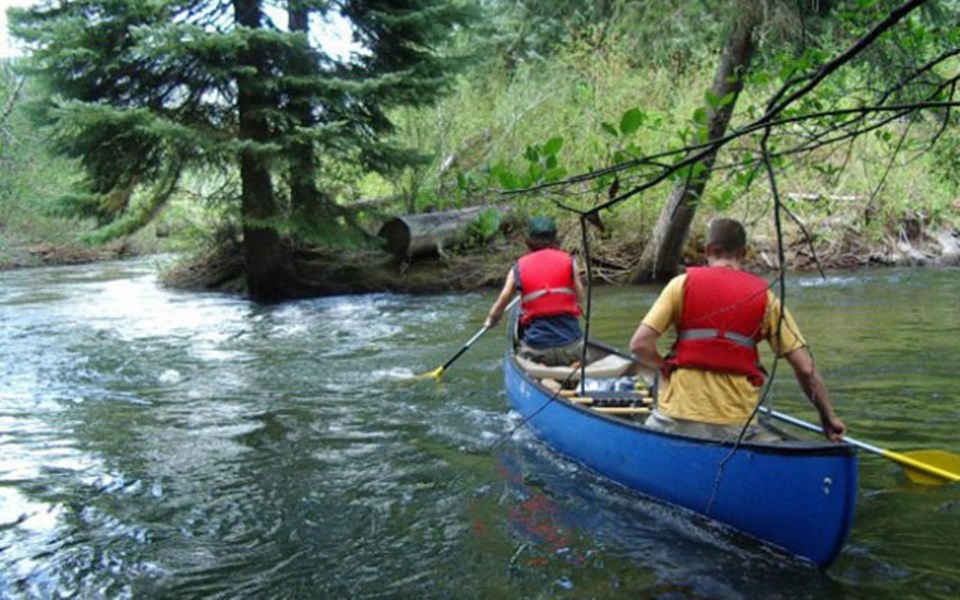The Resort Municipality of Whistler (RMOW) is closing a section of the River of Golden Dreams due to low water levels.
The section between the Alta Lake fish weir and the CN rail bridge — known as the "Tapley's" section — will be closed until there's a significant rise in water levels.
Boaters are asked to launch their boats from the portage trail below the lower railway bridge — accessed from the end of Lorimer Road — or to portage the 600-metre section from the Alta Lake fish weir to the lower railway bridge.
Signs have been placed in the area informing the public of the closure.
The closure is necessary to protect shallow spawning beds and rearing grounds of rainbow trout and kokanee, Whistler Mayor Nancy Wilhelm-Morden said
"I've actually had a number of people speak to me about it because the fish eggs for the rainbow trout and kokanee are in the gravel in the river bed and with the water levels being so low, it gets stirred up with people scraping against the bottom of the river," she said. "So we had to take these steps."
Eric Wight — owner of Backroads Whistler, which offers tours on the river — said the voluntary closure is normal, but about two weeks ahead of schedule.
"It's a little early, no question... I mentioned to Fisheries probably two weeks ago that we should be looking at a voluntary closure here pretty quick depending on what snowpack and temperatures do," said Wight, who is also a member of the Whistler Fisheries Stewardship Group.
But despite the voluntary closure, the River of Golden Dreams remains open for business — Backroads has carts lined up to help guests portage.
The ever-changing face of the river is part of what makes it special, Wight said.
"It can be (challenging) on high water, and in low water it's scenic," he said. "It changes all the time, and that's one of the draws, is that it's so unique."
The early closure is a sign of Whistler's continuing water woes.
"Our monitoring shows that our use of water is higher this year than in past years... because of things like June being 26-per-cent busier than June 2014," Wilhelm-Morden said.
"We're just seeing this overwhelming numbers of visitors to the resort, all of whom use water, so that, in combination with a very low snowpack and a very dry spring and summer, causes concern for sure."
A report focusing on alternative water sources and other contingency plans is expected to come before council in the coming weeks, the mayor said.
In the meantime, residents are asked to be as water-wise as possible, and abide by the Level One sprinkling restrictions that are in place.
FOREST FIRES REMAIN A CAUSE FOR CONCERN
More forest fires ignited over the long weekend, bringing the total number of fires burning in the province to 140.
While 92 of them were caused by lightning, 36 were human-caused.
"This continues to be a source of significant frustration to our wildfire service and to the province and to our ministry," said Steve Thomson, provincial minister of forests, lands and natural resource operations.
"We need increased vigilance, increased attention to the restrictions that are in place across the province, and need to have the support of all of the public when they're out in our recreation areas, being ever, ever vigilant.
"One human-caused fire is one too many."
A new Coastal Fire Centre wildfire — determined to be human-caused — was discovered on Aug. 2. As of Aug. 4, the Wood Lake fire was zero-per-cent contained and burning on 600 hectares 20 kilometres north of Harrison Hot Springs.
The Boulder Creek wildfire was 45 per cent contained, with 6,365 hectares still burning about 23 kilometres northwest of Pemberton Meadows.
The Elaho wildfire — burning 12,899 hectares west of Pemberton — was 40-per-cent contained.
There are various fire bans in place in the Coastal Fire Centre — head to www.bcwildfire.ca for up-to-date information.




